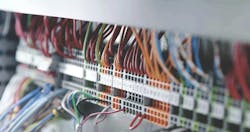Terminal blocks: small component with big cabinet impact
Key highlights
- Terminal blocks have evolved from bulky wiring components to highly integrated, space-saving devices crucial for automation systems.
- Terminal blocks incorporate features like fusing, circuit isolation and electronic components to enhance system efficiency and troubleshooting.
- The continuous innovation in terminal block design, including increased density and diverse termination options, directly supports the ongoing miniaturization and sophistication of industrial automation panels.
Some time ago, around the early 1980s, terminal blocks were big but secure. Panels built with programmable logic controllers (PLCs) and starters had hundreds of them, which took up a huge percentage of panel space.
They were meant to have all field wiring coming into the panel to a terminal block, with the inputs and outputs of the PLC on the other side of the block. This was the main use of terminal blocks in the early age of automation.
Relay type panels didn’t use the same strategy—point-to-point wiring is how panels were built, and some of those panels were very large, not leaving much room for row upon row of terminal blocks.
The IEC style of terminal block entered the North American market, which some suppliers resisted until they could no longer support larger panel sizes due to the oversized terminal blocks.
The terminal block was and is used to terminate wiring, making it easier to wire panels, as well as troubleshoot field hardware failures inside the panel. Safety and serviceability to allow for quick failure resolutions is paramount in automation systems.
The evolution of the terminal block has been explosive. The panel wiring has gone from simply providing wiring clarity to being an integral part of the automation.
I remember when a fused terminal block with blown fuse detection was introduced into the PLC output wiring. In the beginning, the fusing was on the output card itself, with a single blow fuse indicator for the module. That level of fusing went downstream to the terminal block, which made the output modules more compact and gave the ability to isolate a failed output circuit due to overcurrent.
A similar operational function was introduced, which allowed the user to isolate a circuit by removing a pin from the terminal block, allowing for easier startup sequences and circuit isolation.
So, how have these blocks evolved? The number of vendors has increased, indicating that it is a large market for the product. With the footprint of most automation products shrinking, the panel size becomes important. Gone are the days of terminal blocks taking up to 50% of the panel space.
Terminal block density has increased due to the connectivity options. Saddle screws have been replaced with pressure terminations, so a screwdriver need not be applied.
NAMUR sensors have their own terminal block, allowing for intrinsically safe devices to be used in a standard automation panel. The required barrier interface is housed in a terminal block form factor.
Get your subscription to Control Design’s daily newsletter.
Electronic components have become part and parcel of terminal block designs. Instrument devices, such as temperature, used to have a separate transmitter to convert native signal voltage/current—think thermocouple—to a signal level that the automation can use in its infrastructure. Specialty I/O modules were being used in the PLC I/O structure at a cost. Most of these modules have multiple points on the module, so, if you only needed one, you paid for four. This level of interfacing can now be put into a terminal block to provide a signal level that exists in the PLC structure.
Analog I/O modules typically have two to eight points of connection. For these subsystems, some modules allow you to configure each point for voltage or current. Some do not. Being able to implement a voltage-to-current conversion terminal block to maximize the use of the I/O modules saves space and money.
Preconfigured terminal block groups can be implemented with a wiring harness to make connectivity to certain PLC I/O modules easier. This relieves the installer from having to wire from the PLC I/O module to a terminal block. This also makes I/O module replacement much easier and faster.
Various vendors have incorporated different termination options. Some allow for the wire to be pushed into the terminal block, allowing for very quick and reliable connectivity. Others have incorporated a tension clamp option, which requires the user to bend the clamp back to insert the wire and then release to provide a connection.
A screw terminal is always an option.
Power terminal blocks and large cable blocks have always been available, but there are times where a direct connection would be best. The automation design needs to take this into account for those systems that require maintenance clarity.
Terminal blocks are the bread and butter of panel design. Smaller panel size, higher density installs and specialty blocks enhance the automation system for both the design phase and the maintenance phase.
Terminal block aren’t just for breakfast anymore. Go forth and terminate.
About the Author

Jeremy Pollard
CET
Jeremy Pollard, CET, has been writing about technology and software issues for many years. Pollard has been involved in control system programming and training for more than 25 years.

